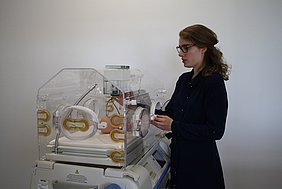Donnersdorf, 28/11/2022. Premature babies need intensive medical care. That’s why these children are kept in a protective incubator at neonatal intensive care units, where they undergo special monitoring. A wide variety of devices measure the vulnerable infants’ vital parameters in order to enable rapid medical intervention if their health deteriorates. However, the measuring methods use so far usually require direct physical contact, as the wires, electrodes, or tubes of the monitoring instruments must be attached to the infant. This often leads to irritated skin, allergies, or pressure ulcers for the underdeveloped and sensitive premature babies.
NeoWatch research project
Launched in 2018, the NeoWatch project tackles this problem. By harnessing technical innovation and synergies, a modern measuring system is in the making that will minimise the physical strain on babies, provide safe monitoring, and lessen the burden on hospital staff in their day-to-day work.
To get a comprehensive picture of vital signs, different technologies need to work together perfectly. Combining them together is meant to achieve optimum measurement reliability and precision.
However, the interplay of the individual measuring methods as well as the data processing present a challenge. That’s why a research team at the Nuremberg Institute of Technology is developing complex algorithms for image and signal processing. By fusing data and analysing it, it is possible to determine the vital parameters that medical staff require.
Technologies used for monitoring
A total of three camera systems are integrated in the current prototype: a thermal imaging camera for measuring body temperature and breathing, an RGB colour camera, and a time-of-flight camera that outputs a three-dimensional cloud of points for detecting respiratory motion.
In addition, radar detection has now been added – an extremely important component, which, however, entails even more complex signal processing. The integrated radar unit takes the prototype to the next level technologically. It enables the detection of changes in distance in the micrometre range. This enables even the heartbeat to be recognised. Another advantage of radar motion detection is that its functionality isn’t impacted by lighting conditions. It is generally kept dark in neonatal intensive care units, since the children are highly sensitive, but that presents no problem for this sensor technology, which detects every breathing motion and the heartbeat.
Radar detects heartbeat
The monitoring system utilises a high-resolution CW radar operating in the ISM (industrial, scientific, and medical) frequency band. It has 6 channels (2 input and 4 output ports) and calculates the relative distance in the micrometre range based on phase shift. One of the problems with radar is that other objects or people in the vicinity cause unwanted reflections due to their movements. Complex signal processing and filter functions can help eliminate such measurement errors. Advanced radars ignore unwanted interference and provide reliable detection.
For its prototype, the NeoWatch team selected InnoSenT’s iSYS-4001 radar system, which was already in use in the GUARDIAN research project for the monitoring of elderly people’s vital signs. The system is even able to detect irregularities with the heartbeat. This technology can be used to identify the first signs of heart attacks or other risks. Radar-based cardiac monitoring is an important innovation in medical technology that not only provides greater comfort for young patients but also significantly improves diagnostics.
However, the experts at InnoSenT not only provided the radar unit needed for the prototype, but also assisted the research team with their radar expertise.
Current state of development
After all the measurement technologies and their signal processing were successfully integrated into the prototype, the time-of-flight camera and radar sensor were tested on a specially built simulator. The system’s reliability and safety must meet the high demands placed on it in neonatal care.
But a large number of bureaucratic requirements have to be met and tests completed before the monitoring system can become established in everyday hospital life. Nevertheless, the research underway is already providing hope for advanced technology that will improve the monitoring, comfort, and medical care for premature babies.
You will find further information on the research project on the website of the Nuremberg Institute of Technology.
www.th-nuernberg.de/fakultaeten/efi/forschung/forschungsaktive-labore/mobile-robotik/neowatch/.
You can visit www.innosent.de/unternehmen/forschung-entwicklung/ on the company website to find out more about InnoSenT GmbH’s research activities.
Words: 769
Publication only with acknowledgement of source and consent of InnoSenT GmbH. For printable images or more information about this topic feel free to contact the InnoSenT Company. InnoSenT GmbH is pleased to receive a voucher copy.
About InnoSenT GmbH
InnoSenT GmbH from Donnersdorf was founded in 1999 and is one of the world's leading companies in the field of radar technology. As a manufacturer and developer, the company supplies the full bandwidth of engineering services - from customer-specific development to series production. Thanks to the strong focus on quality and innovation, InnoSenT GmbH has been following a course to global success for many years.
More information can be found at www.InnoSenT.de








